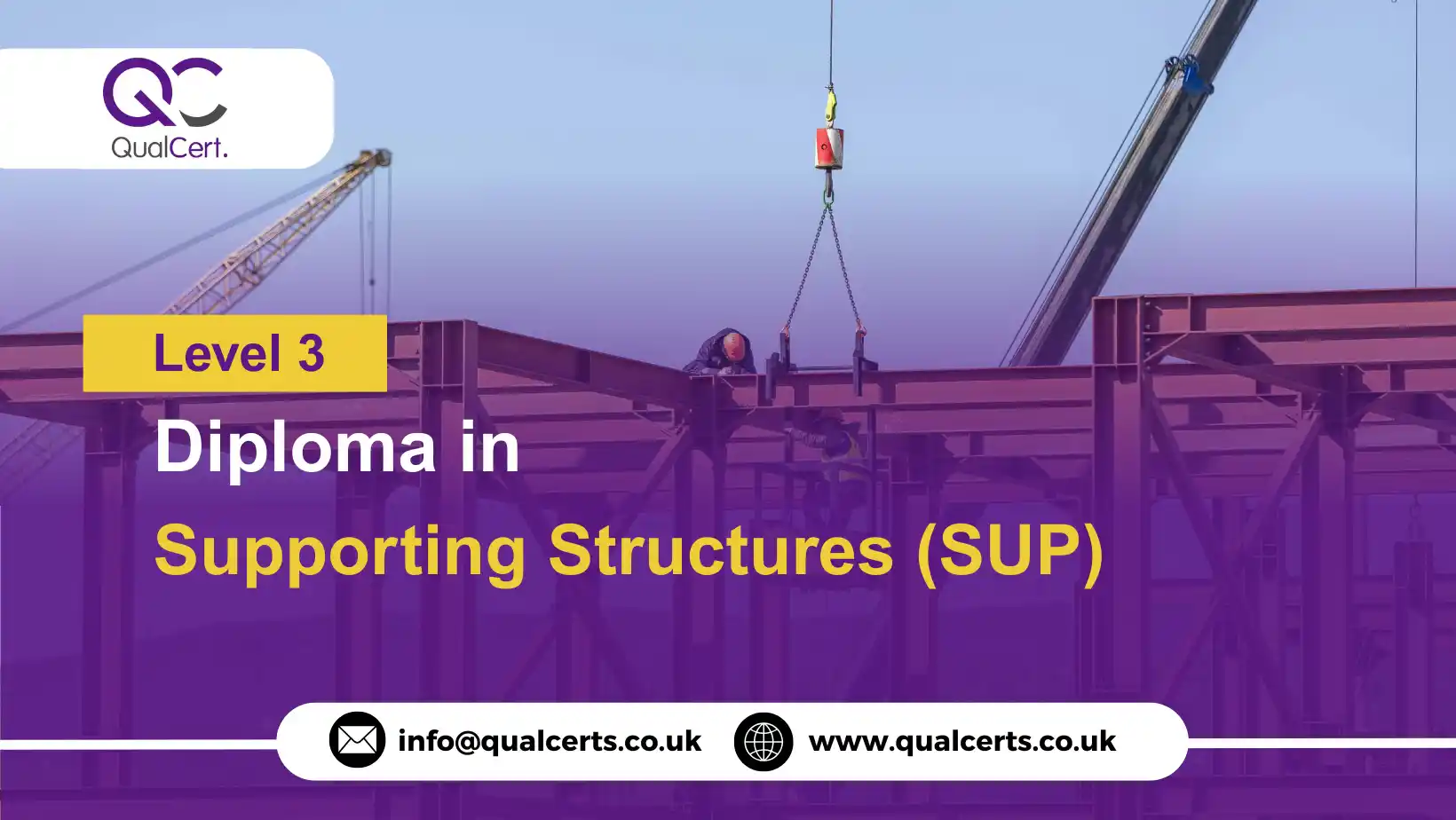The QualCert Level 3 Diploma in Supporting Structures (SUP) is a specialised vocational qualification designed to equip learners with the knowledge and practical skills required to work safely and effectively with structural support systems across various industries. This includes temporary and permanent supporting structures such as scaffolding, shoring, bracing, falsework, and other load-bearing frameworks.
Ideal for individuals working in construction, civil engineering, infrastructure development, and industrial maintenance, this diploma provides in-depth understanding of structural stability, load distribution, material selection, and safety compliance. Learners will also gain expertise in identifying structural hazards, interpreting technical drawings, and assisting in the erection, inspection, and dismantling of supporting structures.
The course aligns with international safety standards and regulations, such as OSHA, BS, and EN codes, making it highly relevant for both local and global job markets. By combining theory with real-world application, the qualification ensures learners are ready to contribute to safe and stable work environments.
Whether you are a site technician, scaffold assistant, construction operative, or aspiring supervisor, the Level 3 Diploma in Supporting Structures strengthens your career prospects and helps organisations maintain structural integrity and regulatory compliance.
Course Contents of QualCert Level 3 Diploma in Supporting Structures (SUP):
The QualCert Level 3 Diploma in Supporting Structures (SUP) offers 60 Credits, requiring a Total Qualification Time (TQT) of 300 hours, including 210 Guided Learning Hours (GLH).
| Unit Ref# | Unit Title | Credit | GLH | TQT |
| QC13054-1 | Introduction to Supporting Structures | 10 | 35 | 50 |
| QC13054-2 | Materials and Components Used in Support Systems | 10 | 35 | 50 |
| QC13054-3 | Erection, Installation, and Dismantling Procedures | 10 | 35 | 50 |
| QC13054-4 | Inspection and Maintenance of Supporting Structures | 10 | 35 | 50 |
| QC13054-5 | Legal and Regulatory Compliance | 10 | 35 | 50 |
| QC13054-6 | Safety, Risk Assessment, and Emergency Response | 10 | 35 | 50 |
Entry Requirements for the QualCert Level 3 Diploma in Supporting Structures (SUP):
To enroll in the QualCert Level 3 Diploma in Supporting Structures (SUP), following are requirement:
- Minimum Age
Learners must be 18 years of age or older at the time of enrolment. - Educational Background
A minimum of a Level 2 qualification (or equivalent) in construction, civil engineering, or a related technical field is preferred. Applicants with basic literacy and numeracy skills will be considered, provided they can understand technical documents, safety instructions, and complete assessments. - Experience
It is recommended that learners have at least 6 months of practical experience in construction, scaffolding, infrastructure work, or any role involving the use or support of temporary or permanent structures. Candidates currently working in a relevant field, even under supervision, may also be eligible. - Language Proficiency
Learners must have a good level of spoken and written English to participate in discussions, follow training materials and complete written assessments. For non-native speakers, an English level equivalent to CEFR Level B2 or higher is recommended.
Learning Outcomes of QualCert Level 3 Diploma in Supporting Structures (SUP):
1. Introduction to Supporting Structures
Learning Outcomes:
- Identify and describe different types of supporting structures used in construction and engineering.
- Understand the basic principles of structural stability and load-bearing systems.
- Explain the functions and purposes of scaffolding, shoring, falsework, and bracing.
- Use correct terminology related to structural support systems.
- Recognize where and how supporting structures are applied in various industries.
2. Materials and Components Used in Support Systems
Learning Outcomes:
- Identify the materials commonly used in structural support systems (e.g., steel, aluminium, timber).
- Understand the mechanical properties and load capacities of different materials.
- Select appropriate materials and components based on design and safety requirements.
- Handle, store, and maintain support system materials correctly.
- Recognize the role of fittings, joints, and connectors in maintaining structural integrity.
3. Erection, Installation, and Dismantling Procedures
Learning Outcomes:
- Follow step-by-step procedures for safely erecting and dismantling supporting structures.
- Use tools and equipment effectively during installation and removal processes.
- Demonstrate teamwork and clear communication during structural operations.
- Apply safety protocols to prevent collapse or structural failure during work.
- Identify and mitigate potential hazards during setup and dismantling tasks.
4. Inspection and Maintenance of Supporting Structures
Learning Outcomes:
- Conduct routine and periodic inspections on supporting structures.
- Identify common signs of wear, corrosion, damage, or structural weakness.
- Maintain inspection checklists and complete accurate documentation.
- Carry out basic maintenance activities to ensure structural safety.
- Understand the responsibilities of a competent person in inspection processes.
5. Legal and Regulatory Compliance
Learning Outcomes:
- Understand key legislation and standards governing supporting structures (e.g., OSHA, BS EN, ISO).
- Identify the roles and responsibilities of workers, supervisors, and competent persons.
- Ensure compliance with certification, inspection, and documentation requirements.
- Recognize the legal implications of non-compliance in structural support systems.
- Maintain records to support regulatory audits and workplace safety practices.
6. Safety, Risk Assessment, and Emergency Response
Learning Outcomes:
- Identify risks and hazards associated with supporting structure operations.
- Conduct effective risk assessments and apply appropriate control measures.
- Implement safe systems of work for fall prevention, access, and egress.
- Respond appropriately to structural emergencies, collapses, or incidents.
- Develop and follow site-specific emergency response procedures.
The QualCert Level 3 Diploma in Supporting Structures (SUP) is designed for individuals who are involved in the planning, installation, inspection, and maintenance of structural support systems in various industrial and construction environments. This course is ideal for:
- Construction Workers and Site Operatives involved in erecting or dismantling scaffolding, shoring, or bracing systems.
- Civil Engineering Technicians and Infrastructure Workers responsible for supporting formwork, temporary structures, or excavation supports.
- Scaffolders and Scaffold Assistants looking to enhance their technical knowledge and safety practices.
- Maintenance and Repair Crews who deal with the reinforcement and stability of existing structures.
- Health and Safety Officers overseeing the structural integrity and safety of temporary or permanent supports.
- Team Leaders and Supervisors managing worksite operations that involve structural frameworks.
- New entrants to the construction and engineering fields who aim to develop a solid foundation in structural safety and support systems.
This qualification is especially beneficial for professionals working in construction, building maintenance, civil engineering, infrastructure projects, and industrial plant operations, where structural stability and compliance with safety regulations are critical. It also supports career advancement and promotes a safety-first culture in high-risk environments.

